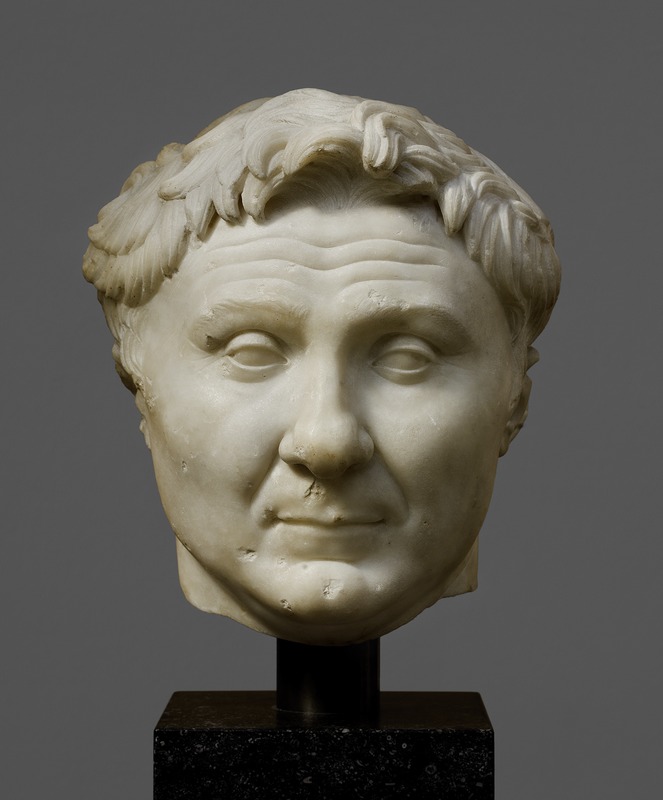Head of Pompey the Great
Title
Head of Pompey the Great
Date
30—50 CE, Claudian
Artist or Workshop
Unknown
Materials
Marble
Height of the work
25 cm tall
Provenience
Rome, Italy, The Licinian Tomb at Porta Pia or on the via Salaria
Current Location
Ny Carlsberg Glyptotek in Copenhagen, Denmark
Description and Significance
Description:
This smooth, veristic, marble sculpture depicts the great Roman general, Pompey. The sculpture is primarily just the head, with a small segment of the neck included. The white marble material shows some signs of age and a few light scuffs, but overall, the piece has been well preserved. The facial features are rendered to look realistic and personalized. Pompey is depicted with a straight forward gaze with a slight curve to the lips. He has a wide round-shaped face that is distinct to his appearance. There are wrinkle lines in his forehead as well as on the sides of his cheeks and chin, showing that he is a middle-aged-man. His hair appears to be shaped and styled similarly to Alexander the Great’s hairstyle but there is still some personalization evident in the change of direction of some of the hair strands. The hair is not quite as long as Alexander the Great’s, but the “lion’s mane” style is still evident. The eyes much smaller and more beady than Alexander the Great’s, and his lips are very thin.
Significance:
It is evident that the facial features were intended to reflect what Pompey actually looked like, rather than to idealize his appearance. The wrinkles in the face and the seriousness of the expression display the periods of focus and stress that Pompey was continuously required to endure in order to become such a powerful military leader. This level of verism in this portrait displays the features that the artist chose to emphasize Pompey's legacy. The similarity in Pompey’s "anastole" hairstyle with Alexander the Great’s stemmed from the fact that he is successor to Alexander’s rule. The lion’s mane hair style displayed that he possessed similar qualities to Alexander the Great and knew what it took to be a great leader. By borrowing elements from portrayals of Alexander, and still keeping individual facial features, Pompey's image was able to be easily recognized and remembered as a great Roman general, while also maintaining a connection of personal truth with the viewer. The original portrait was set up in Pompey's theater in the Campus Martius, where it would have been easily accessible. This marble copy was instead placed in the family tomb of Pompey's Claudian-era descendants where it could only be seen by family members, who came to the tomb to pay respects to the dead.
This smooth, veristic, marble sculpture depicts the great Roman general, Pompey. The sculpture is primarily just the head, with a small segment of the neck included. The white marble material shows some signs of age and a few light scuffs, but overall, the piece has been well preserved. The facial features are rendered to look realistic and personalized. Pompey is depicted with a straight forward gaze with a slight curve to the lips. He has a wide round-shaped face that is distinct to his appearance. There are wrinkle lines in his forehead as well as on the sides of his cheeks and chin, showing that he is a middle-aged-man. His hair appears to be shaped and styled similarly to Alexander the Great’s hairstyle but there is still some personalization evident in the change of direction of some of the hair strands. The hair is not quite as long as Alexander the Great’s, but the “lion’s mane” style is still evident. The eyes much smaller and more beady than Alexander the Great’s, and his lips are very thin.
Significance:
It is evident that the facial features were intended to reflect what Pompey actually looked like, rather than to idealize his appearance. The wrinkles in the face and the seriousness of the expression display the periods of focus and stress that Pompey was continuously required to endure in order to become such a powerful military leader. This level of verism in this portrait displays the features that the artist chose to emphasize Pompey's legacy. The similarity in Pompey’s "anastole" hairstyle with Alexander the Great’s stemmed from the fact that he is successor to Alexander’s rule. The lion’s mane hair style displayed that he possessed similar qualities to Alexander the Great and knew what it took to be a great leader. By borrowing elements from portrayals of Alexander, and still keeping individual facial features, Pompey's image was able to be easily recognized and remembered as a great Roman general, while also maintaining a connection of personal truth with the viewer. The original portrait was set up in Pompey's theater in the Campus Martius, where it would have been easily accessible. This marble copy was instead placed in the family tomb of Pompey's Claudian-era descendants where it could only be seen by family members, who came to the tomb to pay respects to the dead.
References
Ancient Rome Website: http://ancientrome.ru/art/artworken/img.htm?id=3261
Encylclopedia Britanica Website:
https://www.britannica.com/biography/Pompey-the-Great
University of Cambridge Website:
http://museum.classics.cam.ac.uk/collections/casts/pompey-gnaeus-pompeius-magnus
Encylclopedia Britanica Website:
https://www.britannica.com/biography/Pompey-the-Great
University of Cambridge Website:
http://museum.classics.cam.ac.uk/collections/casts/pompey-gnaeus-pompeius-magnus
Contributor
Gentry Pack
Citation
Unknown, “Head of Pompey the Great,” Digital Portrait "Basket" - ARTH488A "Ancient Mediterranean Portraiture", accessed June 6, 2025, http://classicalchopped.artinterp.org/omeka/items/show/32.
Item Relations
This item has no relations.

